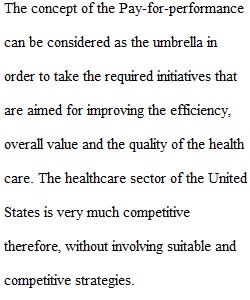


Q Question: Pay for Performance is increasing as a means to support providers, especially physicians, and improve quality of care outcomes. The costs may or may not be justified. One justification is that costs may go down if the providers are cognizant of overall costs and the costs to the pay for performance is less than the costs saved. However, one might contend that other means could lead to the same reduced costs (health administrators’ oversight on procurement costs). Indicate your perspective on Pay for Performance for physicians (MDs or DOs) along the continuum indicated below, and provide an article that supports your perspective (three references for reliability purposes). Pay for Performance Continuum (you can use all numbers 1-10): PFP PFP Should Never Be Used = 0 PFP Should Be Limited = 3 PFP Should Be Used in 50% of Care = 5 PFP Should Be the Rule – Exceptions to Not Use it (e.g., Emergencies) = 7 PFP Should Be Used all the Time with Salary: 9 PFP Should be the Only Pay (No Salary Base): 10
View Related Questions